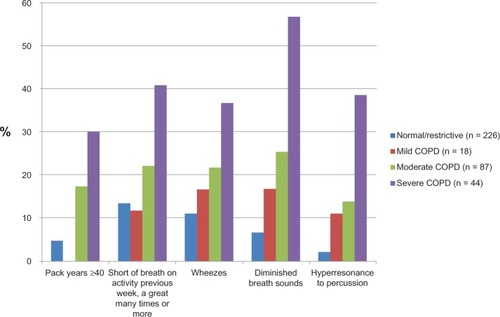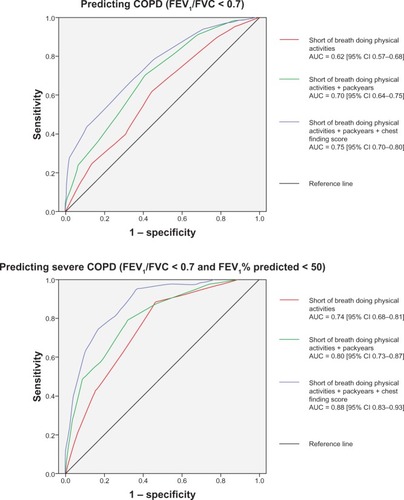Figures & data
Table 1 Questions on shortness of breath, cough, and phlegm in the clinical COPD questionnaire (CCQ)
Table 2 Sex, age, diagnosis, smoking history, lung function (by GOLD stages), respiratory symptoms, and chest signs in 375 patients aged ≥40 years diagnosed with asthma or COPD in primary care
Figure 1 Frequency of heavy smoking, shortness of breath, and chest findings by level of lung function in 375 patients aged ≥40 years diagnosed with asthma or chronic obstructive pulmonary disease (COPD) in primary care. The patients were in a stable phase of illness.

Table 3 Values of smoking habit, respiratory symptoms, and chest signs in predicting COPD (postbronchodilator FEV1/FVC < 0.7) in 375 patients diagnosed with asthma or COPD
Table 4 Diagnostic values of smoking habit, respiratory symptoms, and chest signs in predicting severe COPD (postbronchodilator FEV1/FVC < 0.7 and FEV1% predicted <50) in 375 patients diagnosed with asthma or COPD
Table 5 Independent predictive values of smoking, respiratory symptoms, and chest signs for COPD (FEV1/FVC < 0.7) and severe COPD (FEV1/FVC < 0.7 and FEV1% predicted <50), as evaluated by multivariate logistic regression in 351 patients diagnosed with asthma or COPD
Figure 2 Receiver operating-characteristic curves showing predictive value of three different scores in predicting COPD (FEV1/FVC < 0.7) and severe COPD (FEV1/FVC < 0.7 and FEV1% predicted <50): dyspnea score (short of breath doing physical activities in the clinical COPD questionnaire), summing up of dyspnea score and pack-years (0–10, 1; 10–20, 2; 20–40, 3; ≥40, 4), and summing up of dyspnea score, pack-years, and chest-finding score (addition of wheezes, 1; diminished breath sound, 2; hyperresonance to percussion, 3).

Table 6 Sensitivity analysis comparing lung function, the prevalence of any chest sign, and the sensitivity, specificity, and likelihood ratio of any chest sign for COPD in practices where patients were examined before spirometry and after spirometry